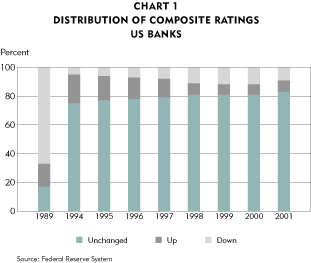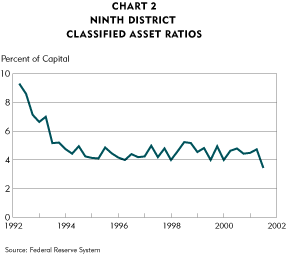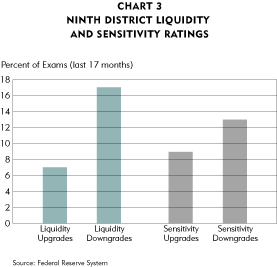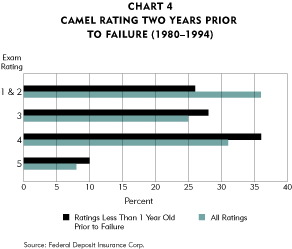Some observers argue that 2001 will bring an end to nearly a decade of strong banking conditions. Assessments of banks by examiners provide a check on such forecasts because examiners have access to otherwise private information on banking conditions. Examiner assessments suggest that conditions remain generally solid.
For example, examiner assessments of loans and bank management have not weakened to date. However, examiners report incipient signs of weakening in borrowers' future repayment ability. Bank supervisors also appear concerned about the management of bank funding as well as bank exposure to changes in interest rates. Moreover, history suggests supervisors must remain vigilant because banking conditions can deteriorate rapidly.
Using examiner assessments to evaluate conditions
The standard approach to evaluating banking conditions involves reviewing and presenting numerous banking performance statistics, such as the amount of capital banks hold, the amount of loans in default and the earnings of banks. These statistics come from the quarterly data banks submit to regulators. Such ratio analysis certainly provides insight into the conditions of banks. However, an understanding of the strategies of banks, their exposure to changes in market conditions and the quality of bank loans and management would provide a more timely and accurate assessment of banking conditions. It is these underlying factors that ultimately determine bank performance. Bank exams generate the data to gain such a detailed understanding of banks.
Examiners have unique access to the internal workings of banks, particularly smaller banks that rarely issue equity or debt that trades on public markets. Examiners obtain private information on these institutions by reviewing the risk management systems of the bank, interacting with bank staff and management and examining the quality of loans. Based on this private information, examiners generate assessments of the condition of the bank.
Federal Reserve examiners, for example, review 40 percent of the commercial/industrial, agricultural and commercial real estate loans of a bank. Supervisors then classify the loans based on expected performance, with the level of classification determining how much of a reserve the bank must set aside against default. A loan that supervisors deem to be substandard, for example, would have a reserve equal to 25 percent of the loan.
Supervisors also come to opinions about risk mitigation strategies and techniques of a bank. These and other assessments are the inputs for supervisory ratings. Ratings for various attributes of the bank and for the bank as a whole vary from 1 to 5, with 1 being the strongest rating and 5 the weakest.
We rely on the output from this examination process, as well as discussions with Federal Reserve examiners, to come to conclusions as to the conditions of banks in the Ninth District. In the following discussion, we will focus on quality of bank assets and management, bank funding and bank exposure to changes in interest rates for Ninth District banks. Although we would prefer to supplement the views of examiners with assessments from market participants, the vast majority of banks in the Ninth District, as noted, do not issue securities priced in public markets.
To set the stage for the discussion of the Ninth District, it is worth noting that examiner assessments do not indicate significant deterioration in banking conditions on the national level. The percent of bank ratings as of 2001 that remained unchanged has varied little relative to the preceding years. Compare that to a year like 1989 when almost 70 percent of new ratings were downgrades from the previous rating (see Chart 1).

Examiner assessments in the Ninth District
Assessments of the Ninth District from bank supervisors suggest fairly solid conditions in terms of management and asset quality, although there have been some signs of weakening asset quality. Examiners have increased their concern about bank funding and sensitivity of banks to interest rate changes.
Asset Quality. Data from the review of bank loans suggest that asset quality has not changed appreciably over the last several years. In particular, the percent of loans that are classified relative to bank assets in the Ninth District has remained fairly constant (see Chart 2).

Federal Reserve field examiners attribute the solid loan quality in part to a reduction in exposure to agricultural losses, such as through the use of government guarantee programs.
Examiners also believe that bankers in the Ninth District did not relax underwriting standards as much as the largest banks located outside the district. In addition, Ninth District banks have taken steps to actively manage loans that have the greatest potential for default. Even with this good news, examiners expressed some concern for the future. For example, banks appear to have been adding more names to the list of borrowers deserving increased scrutiny.
Funding and market sensitivity. Supervisors were less sanguine about the funding exposure of banks. Examiners have seen an increase in banks' use of noninsured deposit funding. Such funds are more expensive and less stable and, therefore, require greater facility in their management. For example, bank management must have plans to address a loss of uninsured funding at a time when obtaining new sources of money could be more expensive. This type of activity may require new analysis and skills for bank managers.
Bank managers also face a challenge in measuring and managing their exposure to a change in interest rates. An increase in rates can reduce the value of bank assets and increase the cost of bank funding, thus putting the squeeze on bank solvency. Banks have access to sophisticated tools to measure such interest rate risk (IRR). However, examiners are not confident that, on the margin, bank measurement and management have kept up with spikes in IRR. (For more details on IRR in the Ninth District, see "Interest rate risk: What is it, why banks would want it and how to evaluate it" in the July 2000 fedgazette.)
Examiner ratings of bank funding (more formally called liquidity) and sensitivity to IRR reflect the increased concern. The percent of downgrades in the rating of these two areas is one-and-a-half to two times the percent of rating upgrades (see Chart 3).

Management. Examiners assess Ninth District bank management as solid. Examiners support their conclusion by pointing to the proactive steps that managers took in administering their loans and diversifying revenue sources. Examiners also think that bankers have implemented lessons learned during the banking crisis of the late 1980s and 1990s. The current ratings for bank management reflect this stronger assessment in the current period relative to the banking crisis period when nearly a third of bank management ratings fell into the worst three categories (less than 10 percent fall into the worst three categories today).
The current strength of management assessment is at least somewhat comforting when considering the future because managerial competence protects banks from failure. The difference between banks that failed during the last agricultural banking crisis from banks that survived came from decisions made by bank management, rather than factors outside their control. Banks that made more loans as a percent of their assets and grew their loan portfolio faster were significantly more likely to fail. Further evidence attesting to the importance of sound management can be inferred from the geographic location of the agricultural banks that failed, since failed banks were usually located in a county with other agricultural banks that did not fail. This implies that the failure was not necessarily related to a deterioration in the local economy.
Examiner concerns going forward
Federal Reserve examiners believe banks face a number of challenges not yet mentioned. Some banks in rural areas face a difficult time attracting and retaining qualified staff. Over a longer term, bankers in much of the Ninth District must cope with unfavorable, long-term demographic shifts, leading people and funds out of these district markets. While the rapid advancement in information technology can create substantial benefits, it also requires additional human capital that some bankers may find difficult to acquire in the short term.
Probably the greatest threat to strong conditions is a significant downturn in the regional or national economy. Economic downturns can produce a rapid fall in banking conditions. Indeed, history shows that a bank that had a strong supervisory rating can fail in a relatively short period of time (see Chart 4).

Of the banks that failed during the 1980-94 period, 25 percent had a satisfactory or better rating within 12 months of closing. Clearly, bank supervisors cannot rest on current conditions and assessments.







